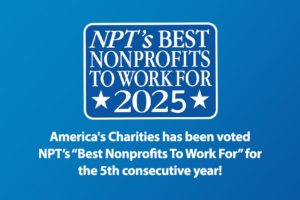Sarah Ford, Vice President Marketing and User Experience, America's Charities | September 2, 2023
The Business Case for Employee Volunteer & Skills Giving Programs
What if I told you that having an employee volunteer program could potentially save you money – say $1,000 to $6,000 per employee. Would you start one? Or if you have one, would you take it more seriously?
The average employee turnover rate of all U.S. industries is 22%. In some cases, this turnover is healthy for your organization because you’re losing low performers (i.e. problem staff or those not willing to improve) and this can positively impact everything from employee engagement to productivity and profits. But what if the employees leaving your organization are top performers?
Replacing top performers can cause service disruptions for your customers and requires a substantial amount of financing, extensive training, employee workload balancing, and handling cultural shifts. None of that sounds good, but how exactly does it impact your company’s bottom line? Employee Benefit News (EBN) reports that it costs employers 33% of a worker’s annual salary to hire a replacement if that worker leaves. In dollar figures, the replacement cost is $15,000 per person for an employee earning a median salary of $45,000 a year, according to the Work Institute’s Retention Report. So for purposes of this article, let’s focus on employees that make $45,000. For each of those employees leaving your organization, it’s costing you about $15,000.
Increased Employee Engagement Helps Employers Reduce Turnover and Achieve Higher Profitability
A PwC study revealed, “Employees most committed to their organizations put in 57 percent more effort on the job—and are 87 percent less likely to resign—than employees who consider themselves disengaged.” According to Gallup, “organizations that are the best in engaging their employees achieve earnings-per-share growth that is more than four times that of their competitors. Compared with business units in the bottom quartile, those in the top quartile of engagement realize substantially better customer engagement, higher productivity, better retention, fewer accidents, and 21% higher profitability. Engaged workers also report better health outcomes.”
So where do employee volunteer and skills giving programs factor in? It’s an excellent, relatively low-cost way to engage and retain employees.
Keep Employees By Engaging Them Through Volunteerism
Employees quit their jobs for many reasons (salary and benefits topping the list), but the majority of reasons are actually something employers can control. HumanResources.about.com sites the following as 10 critical reasons why employees quit their job (in no special order):
- Bad or nonexistent relationship with boss
- Bored and unchallenged by the work itself
- Lack of relationships/friendship with co-workers
- Opportunities to use skills and abilities
- Contribution of work to the organization’s business goals
- Autonomy and independence
- Meaningfulness of work
- Organization’s financial stability
- Overall corporate culture
- Management’s recognition of employee job performance
Instituting an employee volunteer and skills giving program can help your organization address all ten of these.
Camaraderie
(addressing #1 and 3 from list above)
Organizing group days of service provide co-workers (and their bosses) an opportunity to work together and get to know each other outside the walls of the workplace. There is no corporate hierarchy when it comes to hands-on in-person or virtual/remote volunteer activities like filling afterschool snack bags for low-income children, cleaning up trash at the local park, or contributing specialized skills like web design or accounting for a local nonprofit. Such activities permit employees from different departments and different levels of seniority the chance to share experiences together and interact on a deeper level, resulting in stronger relationships when they return to the office. In UnitedHealthcare and VolunteerMatch’s study, Doing Good is Good for You, “85% of volunteers note developing friendships through their volunteer activities.”
Corporate Culture & Meaningful Work
(addressing #2, 4, 5, 6, 7, and 9 from list above)
It’s well known that employees want to work for companies that care. In fact, America’s Charities Snapshot Employee Research found that 71% of employees surveyed say it’s imperative or very important to work where culture is supportive of giving and volunteering. When strategically integrated with your company’s business goals and values, involving employees in a mix of volunteer work, skills giving, workplace giving programs, and matching gift opportunities gives employees a sense of purpose, and makes them feel more connected to the community and your company-wide social responsibility efforts. In fact, matching gifts is one of the top five motivations for workplace donors when it comes to employee engagement programs. Not familiar with matching gifts? Learn how matching gift programs work here.
Additionally, volunteer programs – particularly those with pro bono and skills giving opportunities – provide a meaningful way for employees to put their abilities to use, and give them a chance to grow and develop professional skills. Integrated online giving and volunteer management tools like America’s Charities’ Engage CSR solution make it easy for companies and their employees to connect their skills with nonprofit needs and volunteer opportunities. According to a Deloitte Volunteer IMPACT Survey, “92% of surveyed corporate human resources executives agree that contributing business skills and expertise to a nonprofit can be an effective way to improve employees’ leadership and broader professional skill sets.”
All of this effectively reinforces beliefs and behaviors most valued by your company, empowers employees to grow and do things for which they are most passionate, infuses pride and loyalty in employees, and contributes to a stronger, more skilled workforce.
Employee Recognition & Financial Stability
(addressing #8 and 10 from list above)
Based on results from the State of the American Workplace report, Gallup estimates that actively disengaged employees cost the U.S. between $483 billion to $605 billion each year in lost productivity. They are more likely to steal from their companies, negatively influence their coworkers, miss workdays, and drive customers away.
Engaged employees are happier, healthier, and perform at a higher level. UnitedHealthcare and VolunteerMatch’s study reaffirms that “volunteering has a proven positive effect on physical and mental health” and research from the University of Georgia Terry College of Business shows that employee volunteering is linked to greater workplace productivity and satisfaction. Jessica Rodell, author of the research, says, “Overwhelmingly employees who volunteered gave more time and effort to their jobs, were more willing to help out their colleagues, talked more positively about their companies and were less likely to do detrimental things like cyberloaf or waste time on the job.”
When employees perform well and contribute to business goals, this gives management more reason to recognize those employees’ efforts. In the Millennial Impact Report, “More than half (53%) of respondents said having their passions and talents recognized and addressed is their top reason for remaining at their current company.” When companies recognize employees for good work, it reinforces that behavior and sets the foundation for a pattern of positive performance in the future. A case study of an employee recognition program established by The Walt Disney World Resort showed “a 15% increase in staff satisfaction with their day-to-day recognition by their immediate supervisors. These results correlated highly with high guest-satisfaction scores, which showed a strong intent to return, and therefore directly flowed to increased profitability.”
Monetizing Volunteerism
There are a variety of ways to structure an employee volunteer program and a wide range of volunteer activities to offer, including day of service events, ongoing volunteer opportunities throughout the year, skills giving and pro bono services. Choosing the right mix ultimately depends on what your employee interests and company goals are, as well as what type of support nonprofits need.
When it comes to measuring employee volunteer and skills giving programs, companies typically track things like the number of hours volunteered, employee participation rates, types of services delivered and to whom, and employee values such as satisfaction and skill development. But did you know volunteer time can be monetized?
Volunteerism is a difficult concept to monetize because the myriad ways volunteers contribute are not always measurable. But in looking at what is quantifiable, Independent Sector estimates the national value of each volunteer hour is worth $27.20 per hour. Derived from the U.S. Bureau of Labor Statistics’ database of job functions and mean wages, this calculation is a way to assign a monetary value to the time your employees donate. So if 50 of your employees each volunteer 8 hours to a nonprofit throughout the course of a year, instead of reporting that your company volunteered 400 hours, you can share that your company’s volunteerism provided approximately $10,880 worth of volunteer time to that nonprofit. That’s a significant business contribution to the community, and a value your board and other important stakeholders are more likely to comprehend and appreciate.
Investing in Employee Volunteer & Skills Giving Programs is Good Business Sense
How much a company invests in its employee volunteer program will depend on a variety of criteria. Typical company investments can easily range anywhere between $18 to $800 per employee per year. If we go back to our example of the company with 50 employees and an average of 5 employees leaving each year (a 10% turnover rate) – let’s assume the company in our example invests $179 per employee each year in employee engagement. This means, it would cost this company a total of $900 to $8,950 a year to implement an employee volunteer program for all employees combined. That’s a pretty low cost to absorb when you consider that it would cost the company roughly $15,000 to replace just one of those employees ($75,000 to replace five).
Employee volunteer and skills giving programs have steadily been moving towards the center of many corporations’ social responsibility initiatives over the last decade. This surge in interest in volunteerism coincides with the dire need many nonprofits have for support. More than ever, charities are better positioned and interested in partnering with companies and engaging with corporate employees. However, as a survey respondent stated in America’s Charities Snapshot Nonprofit Research: Rising Tide of Expectations, “Companies shouldn’t look at their work with nonprofits as transactional events but rather as building a relationship with a trusted ‘go to’ partner that is working to achieve mutual goals.” Through employee volunteer and skills giving programs, companies have the opportunity to help build nonprofit capacity and empower employees to give their time and talent. And all of this is good for the company’s employee retention and bottom line.
Get Started Now! What can we help you with?
Learn more about how a well-designed corporate philanthropy program can meet your needs. Click here for more information about our employer solutions and to request a call with our team.

Get Resources and Insights Straight To Your Inbox
Explore More Articles
For Fifth Consecutive Year America’s Charities Named ‘Best Nonprofit To Work For’
Washington, D.C. – April 1, 2025 – America’s Charities, the nonprofit that mobilizes the power of giving as a leading provider of volunteering, workplace giving,…
Read ArticleWorkplace Fundraising + Volunteering Summit (April 2nd and 3rd, 2025)
Join us in attending this virtual summit! The America’s Charities team is joining up with other leading voices in the workplace giving space for a…
Read ArticleThe Time to Act is Now
The results of the 2024 National Assessment of Educational Progress (NAEP) are in, and the findings are, in a word, heartbreaking. This assessment serves as…
Read ArticleGet Resources and Insights Straight To Your Inbox
Receive our monthly/bi-monthly newsletter filled with information about causes, nonprofit impact, and topics important for corporate social responsibility and employee engagement professionals, including disaster response, workplace giving, matching gifts, employee assistance funds, volunteering, scholarship award program management, grantmaking, and other philanthropic initiatives.




